
Across the forests and prairies of Asia, and vast savannahs of Africa, live secret societies of tiny termite architects. They are masters of construction, their sophisticated green-energy designs perfectly adapted to their often hot and arid surroundings. Most homeowners are aware of the destructive power of an army of termites but the fungus termites of Southern Africa are the focus of life and regeneration on the African savannah. With the aid of fungus farms, tended deep within the nest, the termites of southern Africa transform wood and dead leaves into organic nutrients which sustain vegetation and provide shelter and food for the surrounding wildlife. The 33 pounds (15 kilograms) or so of termites in a typical mound will, in an average year, move a fourth of a metric ton (about 550 pounds) of soil and several tons of water. They are not only remarkable architects of their own living spaces but are an essential part of the ecosystem and survival of virtually all the life around them. Termites transform the ecosystem in a variety of complex ways. Termites import coarse particles into the otherwise fine soil in the vicinity of their mounds which promotes water infiltration of the soil. The mounds also show elevated levels of nutrients such as phosphorus and nitrogen. All this beneficial soil alteration appears to directly and indirectly mold the ecosystem far beyond the immediate vicinity of the mound.
Active and Abandoned Termite Mounds



I have included a close-up photograph to illustrate the features of an active termite mound, in this case Macrotermes michaelseni. Here we can see both older construction in light tan and newer dark brown construction patches. You can also see both smaller and larger openings at the top of the mound that function as gas and heat exchange vents. The mound is constructed out of a mixture of soil, termite saliva and dung. Although the mound appears solid, the structure is incredibly porous. Its walls are filled with tiny holes that allow outside air to enter and permeate the entire structure. Also of note are the bird droppings on the top of the mounds since this elevated location is a favorite of local birds, in particular hornbills. A mutualistic relationship has evolved between dwarf mongooses and hornbills, in which hornbills seek out the mongooses in order for the two species to forage together, and to warn each other of nearby raptors and other predators.


All mound-building termites species do not have the same sized or shaped mounds as you can see in the above photos. In a study of the foraging and distribution patterns of termites in the Okavango delta, Gregor Shuulman identified the wood-feeding species present in the semi-arid Okavango Delta region of northern Botswana. Seven wood-feeding species were found. Fungus-growing termites dominated in all areas, and four species (Macrotermes michaelseni, Odontotermes sp. A, Allodontermes sp. and Microtermes sp.) were found in most. Foraging by smaller-bodied Allodontermes sp. and Microtermes sp. was largely confined to the wet season. Foraging by M. michaelseni and Odontotermes sp. A was more constant, but showed a general peak in the early dry season (May and June), likely due to nutrient and energy demands associated with alate production (immature flying king and queen termites).



If the inner tunnels of the nest are exposed, the termite mound is usually dead. Sometimes other colonies, of the same or different species, occupy a mound after the original builders’ deaths. Termite mounds can survive fire, but can be washed away in flash floods. A typical mound takes between four and five years to construct, but one third can disappear in a single heavy downpour, meaning the termites are always working to rebuild the structure. The structure of the mounds can be very complicated, comprising an extensive system of tunnels and rooms that serve as a ventilation system to keep it cool, to maintain an even balance of carbon dioxide and to provide water to the nest. There are numerous gallery chambers in different shapes and sizes, including one for the queen, whose job it is to lay eggs, rather than command a colony. While workers and soldier termites only live up to two years, many termite queens can survive for up to 25 years.
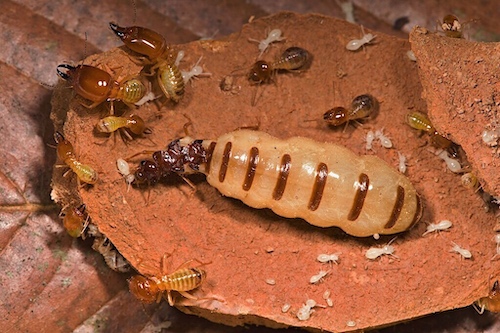

The African mound-building termite queen can grow as old as 60 years (she’s the longest living bug in existence). However, it’s more common for a queen to live 15–20 years. The queen produces an egg every three seconds for 15 years and as time goes on her body distends. What starts off as being the length of a dime extends to be about the size of a human index finger. As the workers construct elaborate vaulted chambers that can rise as high as 30 feet above ground, the king remains inside a protective capsule with the queen throughout her life. Inside the termite mound is a world filled with nonstop activity and purpose. Each termite has a highly specified job. There are worker termites, soldier termites, and a special group of males and females called “alates” that are able to reproduce. The nymphs are a caste in intermediate stages of growth, and they give rise to alates or termite swarmers. Their appearance is like the worker termites, but juvenile reproductives have bigger size and some little wings, which can differentiate them from the rest. After the first rains have fallen in the Okavango delta millions of winged alates emerge from the termite mounds. Termites emerge in the millions, most of which are preyed on by birds, reptiles and small carnivorous mammals. It has even been noted on occasion that lions have taken part in the feeding frenzy. However, some of the alates find a mate and begin a new termite mound or recolonize abandoned mounds.

Aardvarks ordinarily consume hundreds of thousands of insects in just one single night, burrowing into their nests. An aardvark’s habitat is determined solely by termite and ant availability. This means that aardvarks must constantly relocate to new regions in accordance with the climate. Even in hospitable climatic conditions, aardvarks often struggle to survive on a diet made up solely of termites and ants.
Plants on Termite Mounds
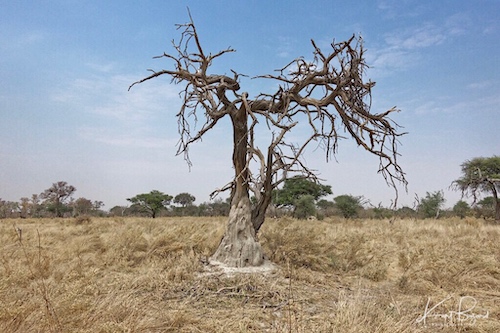



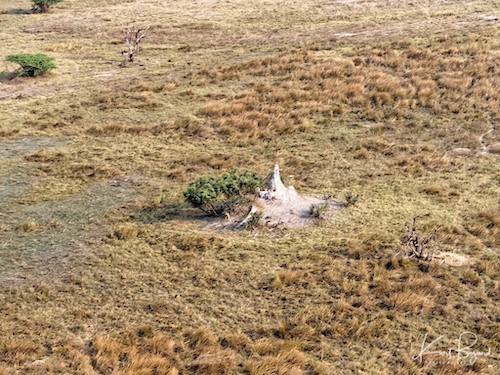
Vegetation on termite mounds differs highly from vegetation in the surrounding area. In African savannas, Macrotermes termite mounds form ‘islands’ with high tree densities. This is usually attributed to the fact that due to the digging of termites and due to their decomposition of plant material, the mound soils are generally more fertile than other soil. On top of that, mound soils have been found to contain more water than their surroundings, a clear advantage for plant growth in savannas. Termite mounds found in arid climates remain moist in the underground nest all year round. The insects need a moist atmosphere not only for their own survival, but also for their fungal “farms”. Termites construct long tunnels, often tens of meters long, down to the water table to access water. During the wet season, the termites regulate the moisture of both the mound and the underground nest (by moving moisture-laden batches of soil around). In the dry season, it would be much harder to keep both the nest and the mound at optimum moisture, so they concern themselves only with the nest. Mounds built in the shade, where there is less evaporation, are often much smaller than those in the open, because there is less need for termites to transfer moist soil pellets from below and add them to the surface of the mound to keep it and the nest moist. So the size of the mound can show the degree of moisture regulation that has taken place.
Termite Islands of the Okavango Delta







The Okavango Delta is unusual in many respects. In October every year, rain falling in the highlands of Angola flows down the Cubango and Cuito rivers that, at the border between Angola and Namibia, join to form the Okavango River. This pulse of water, which accounts for over 60% of water entering the delta, flows slowly downstream over the course of four to seven months, reaching the northern part of the delta between February and May. The mounds of the fungus termites in the Okavango Delta seem to be larger than anywhere else in Africa and they are a dominant feature of the delta. The reason for the mounds seeming to be larger is because of the water table in the delta, and because the water is very close to the surface the termites have to build the main part of their nest above the water table to prevent the nest from being flooded. Most islands in the delta are thought to originate from tree saplings growing on termite mounds. As the trees grow, water and solutes are drawn up from the ground into plants and released through transpiration. This causes the water table to drop over time, which draws in water from the surrounding floodplains to replace it, and so keeps the area replenished with fresh water.
Animals on Termite Mounds


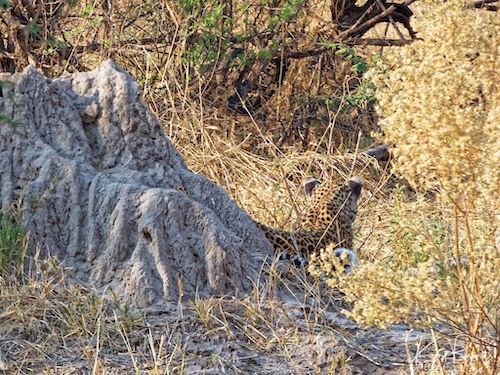


The high tree densities on termite mounds attract browsing herbivores, due to the high nutrient contents in foliage from trees growing on mounds, or perhaps due to the high quantities of food and shelter on mounds. In the Okavango delta, the termites mounds and islands represent the only dry land available during the wet season. With the higher concentration of browsing animals comes the presence of predators such as leopards and jackals. The real truth is that termite mounds are the ”place to be” in the savannah of southern Africa, sort of like the best bar in town. Comfortable seating, shade from the hot sun, things to eat and a little privacy from prying eyes that is sorely lacking away from the mound. Attracting animals to the area around the mound creates a virtuous circle. More animals add to the richness of the soil through their dung and in fact many new plants are introduced via this same dung. The termite mound benefits with increased shade and protection provided by the new plants.
Ancient Fungus-Growing Termites


The fungus-growing termites of the old-world tropics build impressive mounds consisting of thousands of workers and soldiers. These societies domesticated the African fungal Termitomyces mushrooms more than 30 million years ago and became dependent on farming their own fungal food in their often gigantic nest mounds. The termite fungus-farming symbiosis had a single African rain-forest origin and now comprises more than 330 species. Cultivating fungi has allowed fungus-growing termites to become one of the most important decomposer groups in the Old World tropics. Reconstructions by Aanen and Eggleton (see reference below) provide strong evidence that termite agriculture originated in African rain forest and that subsequent termites all owe their existence to this ancient ancestor. The evidence also suggests that the savanna has repeatedly been colonized by fungus-growing termites. Furthermore, at least four independent “out-of-Africa” migrations into Asia, and at least one independent migration to Madagascar, have occurred. Although fungus growing by termites is ecologically most successful under the variable, unfavorable conditions of the savanna, it seems to have evolved under the more constant and favorable conditions of the rain forest.
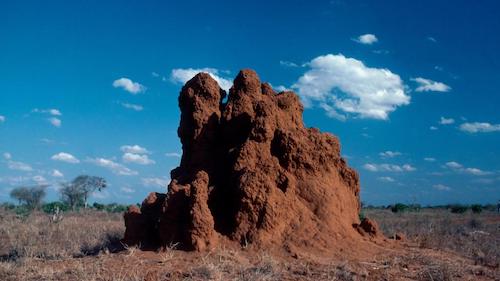

Even though termite mounds are often abandoned, there have been some pretty spectacular reports of active termite mounds as old as 2200 years in Africa and up to 4000 years in the Amazon jungle in Northeastern Brazil. In the Miombo woodland area of central Africa, scientists found an abandoned termite mound that is more than 2200 years old in 2015. Another mound studied in the same area is at least 750 years old, confirming the ancient mound wasn’t an anomaly. The discovery suggested that termites used the same structures for millennia. Researchers reporting in Current Biology on November 2018 found a vast array of regularly spaced, still-inhabited termite mounds in northeastern Brazil, covering an area the size of Great Britain, which are up to about 4,000 years old. The mounds, which are easily visible from space, are not nests, they are the result of the insects’ slow and steady excavation of a network of interconnected underground tunnels. Stephen Martin of the University of Salford in the UK said, “The amount of soil excavated is over 10 cubic kilometers, equivalent to 4,000 great pyramids of Giza, and represents one of the biggest structures ever built by a single insect species.”
Macrotermitinae Termites

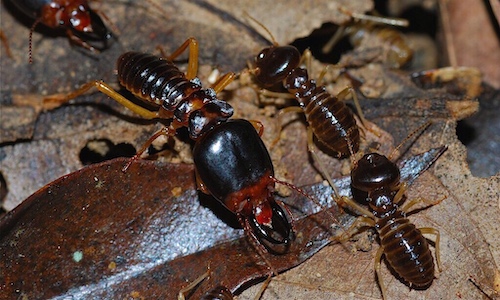
Like other termites, Macrotermitinae or fungus-growing termites are soil engineers, mixing their salivary secretions with soil particles to make their strong, hard mounds and galleries. Their mounds are some of the largest built by any species of termite, with volumes of thousands of liters and lasting for many decades. They are probably the most complex mound colonies of any insect group. There are 11 accepted genera in the Macrotermitinae and about 330 species, with the greatest diversity being in Africa. About 40 species of Termitomyces fungus have been identified as symbionts or partners to the Macrotermitinae termites. The Termitomyces fungus often bear fruiting bodies which produce spores, carried by the termites to seed their gardens. It is believed that transmission of the fungus to other termites is mainly by horizontal transmission (sibling to sibling) rather than by vertical transmission (mother to daughter). Some species are an exception to this, and in all five species of the genus Microtermes tested, the symbiont fungi did not bear sexual fruiting bodies, and transmission was through the maternal route. Another exception was the single species Macrotermes bellicosus where again the fungus did not fruit, and where transmission was paternal.
Inside the Termite Mound


A termite’s colony is like that of a complex large city with specific functions in different areas. It is made up of several chambers that have specific purposes as well as a large number of complicated paths that lead from one chamber to another, including the entrance and exit point of the colony on the broad base of the mound. Included in their colonies are spire chambers that will help circulate air in their system, controlling temperature, humidity and expelling carbon dioxide. In many ways the spire can be seen as the “lungs” of the termite mound. A chamber for the king and the queen are kept separate from the nursery and incubation chamber. Termites also have an area for the fungal Termitomyces garden with benefits derived from the careful temperature, air and humidity regulation. In the cellar are tunnels leading down to the water table and wet mud for building and repairing the mound.
Termite Mound Air and Thermal Regulation


MIT graduate student Samuel Ocko and his colleagues used a combination of thermometers and airflow monitors to observe how conditions changed in Macrotermes mounds over 35 days during autumn in Namibia. They reported their findings in the Journal of Experimental Biology. External temperatures changed by 15 to 20ºC (27 to 36ºF), whilst inside the mounds, conditions varied by just 8º C (15º F) – something humans usually need energy-guzzling air conditioning to replicate. Airflow in the mounds was smooth, powered by convection from the temperature gradient between their centers and outside. Wind only had a secondary influence. Carbon dioxide levels stayed close to 5 percent over 24 hours, with airflow going upwards in the daytime and downwards at night. The mounds have holes up to 0.5 centimeters (0.2 inches) in diameter, allowing for gas exchange and creating a dazzling array of tunnels. Of course we also know the seemingly solid walls of the mound are also very porous, much like lung tissue.
Termite Mound Water Homeostasis

Macrotermes live in environments that are strongly seasonal, with torrential rainfalls and high humidities in the warm summers, and very low humidity and hot temperatures during the winter dry season. This means that the balancing the water budget imposes different challenges throughout the year. In all instances, termites act as active carriers of water, either by drinking from wet soil and storing it in their crops, or carrying it in wet soil. During the dry winter, termites must actively transport water into the nest. This probably comes from termites tunneling vertically down through the soil to water tables. Some assistance in this process of finding water is the existence of hard coliche or calcrete (a hardened natural cement of calcium carbonate) found in layers beneath the soil in arid climates worldwide. This coliche can create pockets of water above the water table making the task of finding water for the termites less difficult. The termites face the opposite problem in summer. Here, the termites face substantial inflows of water during the episodic periods of torrential rains. Now the problem is a surplus of water, which the termites must balance by transporting water out of the nest. Because the mound is generally the dryest soil nearby, the termites move water up into the mound where evaporation carries it away. Secondary assistance during downpours is the broad sloped base of the termite mound that directs water away from the mound like rain-gutters on a house.

I thought I would end this post with a remarkable observation by J. Scott Turner, a professor of animal physiology at the SUNY College of Environmental Science and Forestry in Syracuse, with over 26 years of experience studying termite behavior. While studying termite building behavior, Turner noticed that his subjects seemed to be kissing each other, mouth to mouth, after a complicated ritual that included grooming and begging. Curious, he added fluorescent green dye to their water and discovered that all this “kissing” was actually a bucket brigade, transferring large amounts of water across the mound. A termite can drink half its own weight in water, scurry to a drier part of the mound, and distribute it to other termites. In addition to rebalancing the mound’s moisture level, moving all of this water dramatically changes its shape.
The Termite Mound is an Organism
Despite the length of this post, we have merely scratched the surface of the fascinating world of termites. J. Scott Turner has stated that drawing the boundary of an organism’s physiology at the skin of the animal is arbitrary. Since the structures animals build undoubtedly do physiological work, capturing and channeling chemical and physical energy, Turner argues that structures like termite mounds are more properly regarded as an organism in their own right. Thus the termite mound is the organism and the termites and fungi are component parts of the organism, much like the cells in our own bodies. Fascinating stuff, you can find his book in the references. I hope you enjoyed the post, please let me know what you think.
References:
National Geographic Termite Mounds
Termite Research, State University of New York College of Environmental Science and Forestry
The evolution of fungus-growing termites and their mutualistic fungal symbionts
Solar-powered ventilation of African termite mounds
Cultural significance of termites in sub-Saharan Africa
Variable effects of termite mounds on African savanna grass communities
Termite mounds can increase the
robustness of dryland ecosystems to climatic change
The Mound Building Termite Macrotermes michaelseni as an Ecosystem Engineer
Okavango Delta: Birth of an island
Termites. The Master Builders of the Okavango
4000 Year Old Termite Mounds in the Amazon
A Termite Queen And Her Ultimate Sacrifice: NPR
Fungus-Growing Termites Originated in African Rain Forest
Fungus Growing Termites Originated in Africa 30 Million Years Ago
Fungus-Growing Termites Originated in African Rain Forest. Aanen and Eggleton
The Extended Organism: The Physiology of Animal-Built Structures by J. Scott Turner

